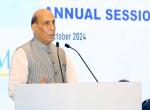In a major technological breakthrough for the Defence Research and Development Organisation(DRDO) and a significant boost to the strike capability of the Indian Navy, the naval variant of India’s home grown fourth generation fighter aircraft Tejas LCA had its successful debut flight on April 27.
The 20-minute long maiden flight Tejas naval at Bangalore has been described as “outstanding success” by the DRDO chief V.K.Saraswat. As envisaged now, the two seater Tejas naval is expected to get Initial Operational Clearance(IOC) by the middle of this decade. According to DRDO, Tejas naval has catapulted India into the elite league of countries capable of design, development and production of four plus generation carrier borne fly by wire fighter. Indeed, the design and development of the Tejas naval involved many formidable technological challenges since it was required to operate under saline and humid environment with restricted availability of deck run for launch and recovery of high operating load conditions. Many new and novel technologies including Leading Edge Vortex Control(LEVCON) surface fitted at the front end of the aircraft wing operated by a concealed rotary actuator with aerodynamic profiling to ensure low landing speed, ground controllability and better vision for the pilot were developed for the first time in the country.
Moreover, Tejas naval has the distinction of being the only carrier borne fighter aircraft in the light category and the second STOBAR (Ski Take off but Arrested Recovery) carrier borne aircraft in the world. Not surprisingly then DRDO points out that Tejas naval fighter will provide a complete marine force multiplier that will help the Indian Navy to position itself as a blue water, maritime force. In yet another boost to the Indian Navy, Defence Minister A.K.Antony informed the Parliament that an exclusive naval satellite for dedicated communications will be launched during 2012-13. The GSAT-7 satellite which will be launched by means of the three stage Geosynchronous Satellite Launch Vehicle(GSLV) will help Indian Navy provide secure and reliable communications channel to link up its “resources and assets” for an integrated operational strategy.
On another front, the induction of the nuclear powered Nerpa class submarine Chakra that Indian Navy has taken on lease from Russia is also expected to enhance the fighting fitness of the Indian Navy. With INS Chakra in operational trim, India has become the sixth country in the world to operate a nuclear submarine. The submarine, considered one of the stealthiest and deadliest in the world, can carry four 533-mm torpedoes and four 650-mm torpedoes. Defence analysts say that with a diving speed of 30-35 knots, INS Chakra will be able to outrun any Chinese or Pakistani submarine.
In a related development, with Russia planning to hand over 45,000 tonne class augmented aircraft carrier INS Vikramaditya with forty years of service life to the Indian navy by 2012 end, the sixty years old Indian navy, the youngest of the three services, can look forward to boost its strike capability . There is no denying the fact that aircraft carriers hold a key to expand the reach and boost the strike capability of a naval force. Indeed, early this year Admiral Nirmal Verma, Chief of the Indian Navy, had stressed on the importance of an aircraft carrier in augmenting the capability of the navy to take care of the Indian interests in the Indian ocean area and beyond.
“Carrier building is very expensive but it is certainly there in our long term plans,” observed Verma. Giving an inkling into the futuristic aircraft carrier that the Indian Navy is keen on operating, Verma pointed out that the navy was firming up the design of a future aircraft carrier by taking into account the emerging advances in the field of aviation and the potentials of unmanned aerial vehicles(UAVs) in the scheme of the naval warfare. “There would be far more capable aircraft and far more expected of an aircraft carrier by the late 2020,” observed Verma. As envisaged now, Indian Navy is keen on operating three aircraft carriers by the end of this decade. The idea is that at any given time, two aircraft carriers should be in full operational trim.
As part of the growth strategy of Indian Navy, Verma has also hinted at deploying UAVs(Unmanned Aerial Vehicles) on INS Vikramaditya sometime in the future. Currently, the INS Viraat, whose refurbishment has resulted in its life being extended upto 2015, is the only aircraft carrier in service with the Indian Navy. And India’s 40,000-tonne home-grown aircraft carrier being built by the Cochin shipyard at Kochi in South India is expected to join the Indian naval fleet by the middle of this decade. Indian navy has also a clear cut plan for a vastly improved second generation indigenous aircraft carrier for deployment by 2018.
Though youngest of the three services, the Indian Navy has been ahead of two other wings in getting its requirements met from the indigenous sources to the maximum extent possible . Indeed, Indian Navy continues to play a pro active role in encouraging the shipyards and industries in the country to take up the development of complex systems involving advanced technological elements. As it is, the allegation of kickbacks associated with German HDW submarine deal in early 1990s had seriously dented Navy’s modernisation plan with a large indigenous contribution. Like the spectre of Bofors which continues to haunt Indian army’s artillery modernization programme, the HDW scandal did seriously sap Indian navy’s combat readiness plan for many years. “After the lost decades, we are now able to place orders and acquisitions are happening; only that our ship yards are unable to deliver at globally competitive rates. But notwithstanding that in the next five years, we would be commissioning on an average five ships or submarines a year,” noted Verma. According to Verma, today Indian Navy is poised for a very good growth path.
In a development of significance to meeting the needs of the Indian Navy, private shipyards such as Pipavav, ABG and Larsen and Toubro(L&T) have invested heavily in technology up-gradation and are more than willing to take up the challenge of building advanced ships, submarines and other systems for the Indian navy. While L&T has made a significant contribution to the construction of India’s first home grown nuclear submarine INS Arihant, Pipavav shipyard, rated as the country’s best shipyard, is building six offshore patrol vessels for the Indian Navy. The state owned Garden Reach Ship Builders and Engineers(GRSE), which has on hand order for building six fast attack craft, has delivered first of the craft well before the deadline, thereby signalling the maturity of the Indian ship building industry. To meet the growing and diverse needs of the Indian Navy, the Ministry of Defence has cleared the participation of private shipyards in the bids along with the public sector shipyards. Mazagaon Dock which is now building three advanced Delhi class destroyers, three Shivalik class stealth frigates and six Scorpene submarines, is focussing on the modular ship design, which is one of the components of the programme for the up-gradation and modernization of shipyards in the country.
In another development of significance, the Ministry of Defence has taken over the Hindustan Shipyard from the Ministry of Shipping with a view to transform it into a hub of nuclear powered submarines. However, the lack of proper ground work and foresight resulted in Government being forced to withhold the joint venture plan between Mazagaon Dock and Pipavav shipyard. Certainly, this would have been a win-win combination, making for a formidable technological base to take up the challenging assignments from the Indian navy. Pipavav is considered one of the most sophisticated shipyards with the largest dry dock in the world and as such has a potential to contribute to self reliance in a big way.
Indian Navy is also working towards boosting its aviation assets aimed at positioning itself as a formidable maritime force. It has already ordered 49 deck based Mig-29K combat aircraft from Russia .Some of the aircraft that navy is planning to acquire in the near future will be designed to operate in the contemporary and futuristic electronic warfare environment with cutting edge technological features. Similarly, Indian Navy is looking at acquiring a range of state of the art helicopters to realize its long term strategic goals. Indeed the plan to acquire six P-81 Boeing long range maritime surveillance aircraft is quite relevant and timely to enhance Indian Navy’s situational awareness domain in the Indian ocean region where the menace of sea pirates has assumed a serious dimension. When Boeing hands over the first P-81 sometime next year, India will become the first non-US operator of this aircraft that will ultimately replace Soviet vintage Tupolev-142 M and Illyushin-38 long range patrol aircraft. Indian navy is also interested in acquiring four more of P-81.
In the ultimate analysis, the accretion plan of the Indian Navy, the forth largest maritime force in the world, looks at operating 150 plus warship of various categories and 500 aircraft including fighter jets, helicopters and maritime reconnaissance aircraft by 2027. Indian Navy’s strike capability will stands enhanced by a substantial extent when Long Range Surface to Air Missile(LRSAM), a guided weapon that the state owned Defence Research and Development Organisation (DRDO) is building in tie up with Israel Air Force Industries(IAI) gets ready for operational use. With a range of 70-km and weighing around 275-kg, the LRSAM with a high performance guidance system will be a force multiplier and game changer for the Indian navy. The trump card of the Indian Navy is the Indo-Russian supersonic cruise missile BrahMos which has already been inducted into some of its warships. The 290-km range BrahMos with a phenomenal destructive power has been described as the “most powerful and most formidable ”naval missile of its kind.
In a related development, Arihant is now poised for extensive sea trials as a prelude to make it fully operational by early 2013. Incidentally, over 6,000-tonne Arihant equipped with a dozen K-15 ballistic missiles will constitute the robust undersea leg of the Indian nuclear triad. As India has a policy of no “first use” of nuclear weapons, survivable retaliatory strike capability is dependent on the this nuclear powered submarine .
Chakra in tandem with Arihant will give Indian Navy a greater manoeuvrability to hoodwink the enemy’s surveillance system and strike hard as they can remain submerged indefinitely . Meanwhile Pakistan, which is, trying to match the Indian Naval capability has said it will build nuclear submarine to meet its defence requirements. “The nuclear submarine would be built in the country” said a government official and added “it would take 5 to 8 years to build the nuclear submarine after which Pakistan would join the list of countries that have a nuclear submarine.”
With China rapidly expanding its naval capability to realize its long standing ambition of challenging the might of American naval fleets moving across the high seas of the world, Indian navy is not willing to be left behind in the race to take care of the Indian interests across the vital global sea lanes. For realizing this vision, Indian Navy would need to strengthen its submarine fleet by a substantial extent. However, right at the moment the submarine asset of the Indian navy, leaves much to be desired. According to India’s public audit watch dog Comptroller and Auditor General (CAG), navy’s submarine fleet is aging fast and by 2012, 63 percent of the vessels would have completed their operational life. The Navy which currently operates just 14 submarines has a submarine strength much below the envisaged force level. All the six Scorpene submarines being built with French assistance at the Mumbai based Mazagaon Dock under Project75 will be delivered between 2015 and 2018. The Scorpene production programme has been marred by delays and cost overruns. Indian Navy is also planning for a new production line of the next generation diesel electric submarine with Russian technology. This project has been cleared by the Defence Ministry.
The Indian Navy is fully well aware of the implications of the rights secured by China’s Ocean Mineral Research and Development Association(COMRA)from the International Seabed Authority for exploring poly-metallic nodules in the Indian ocean region. Indeed, this could serve as a cover to strengthen Chinese naval presence in this vital oceanic body. “The world has anxieties over the rise of China but the two countries that should watch out are India and Japan as China has the capacity to cast a shadow on them,” says Geir Lundestad of Norway’s Nobel Institute. For China, India’s joining hands with Vietnam for oil exploration in South China Sea, over which China claims total and absolute rights, has become a hard nut to crack.
However India’s endeavour to build Chabahar port at the mouth of the Persian Gulf in Iran close to Pakistan’s coastal stretch has entered a phase of stalemate presumably owing to international pressure in the wake of Iran’s vow to continue with its nuclear programme. “If India accelerates the work, the port of Chabahar will come up in record time because the Iranian side is fully equipped and willing to help India in completing the project,” says Mostafa Dolatyar of Teheran’s Institute for Political and International Studies, “For India, access to central Asian oil and gas is entirely dependent on its use of the Iranian ports and Chabahar will be a port dedicated to the Indian needs”.
On his part, Verma is clear in perception, “the Indian Navy’s current perspective level planning is driven by a conceptual shift from numbers of platforms—that is from the old bean counting philosophy to one that concentrates on capacity”.Giving details, Verma points out “In terms of force accretions in the immediate future, we are acquiring ships in accordance with Navy’s Maritime Capability Perspective Plan. Our preferred choice of inducting ships and submarines has been through the indigenous route and of the 49 ships and submarines on order, 45 are from Indian shipyards.”
For with China enlarging its footprint all over the Indian Ocean region through what is being viewed as its aim of creating a “string of pearls” of listening posts around India, Indian navy cannot afford to remain idle. China has already constructed an ultra modern port in Hambantota in Sri Lanka in addition to a number of maritime projects in Myanmar. And to India’s discomfiture, China has also bagged a project to build a deep sea harbour at Sonadiya near Chittagong in Bangladesh. Of course, for geo-political and strategic reasons, China has not obliged Pakistan in so far building a naval base at Gwadar is concerned.
Against this backdrop Indian Navy’s strategy to transform itself into a satellite augmented, network centric three dimensional force, assumes significance. As it is, the Indian Navy has drawn up an ambitious plan to acquire a range of satellites for a variety of end uses in the years ahead. To begin with, it would get GSat-7, a multi band communications satellite built by the Indian Space Research organisation(ISRO). GSAT-7 will help the Indian Navy link up its long range missiles , radar and air defence networks to a central room through a dedicated satellite communications network. The most striking advantage of GSAT-7 is that it would provide secure, reliable and hassle free communications channel. GSAT-7 which will encase the rich and varied experience of ISRO in building INSAT series of communications spacecraft will help smoothen naval plan for a robust net centric war platform. This satellite with 600-100 nautical miles footprints over the Indian Ocean will enhance maritime domain awareness of the Navy over the Indian ocean region which India considers to be the primary area of responsibility in terms of maritime security.
Not even sky seems to be the limit for Indian navy’s ambitions to acquire space assets. Looking ahead, it is keen on acquiring dedicated satellites for applications such as navigation, ocean watch, reconnaissance and surveillance, electronics intelligence and weather prediction in addition to communications and data transfer . The ultimate objective of the Indian Navy is to create and sustain a three dimensional, technology enabled, satellite augmented network centric system to transform itself into a forward looking, formidable sea power. Indian Navy’s radical shift in its strategic outlook is clearly exemplified by the fact that it is aiming for a global reach from being a just regional sea power worried about the threats from China and Pakistan. That Navy is looking well beyond China and Pakistan to position itself as a maritime force capable of taking care of Indian interests across the high seas of the world augurs well for India’s long term strategic vision of attaining the status of a major military power.
Publiahed Date: 31st May 2012








Post new comment